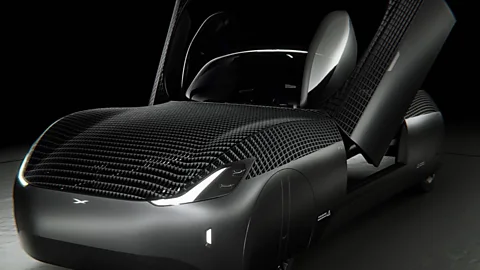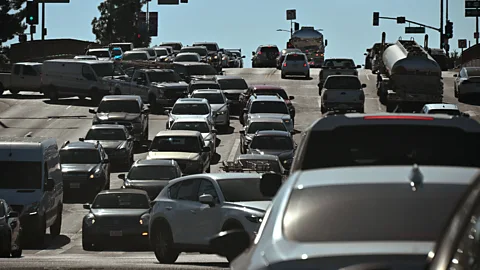What's standing in the way of the flying car?
 Getty Images
Getty ImagesThe era of the flying car appears to be coming closer – but huge challenges remain to be solved.
A new era of flight is about to take off. On 12 June 2023, the Federal Aviation Administration (FAA) issued a Special Airworthiness Certificate to a flying car model developed by Alef Aeronautics, allowing the aircraft to fly in limited locations for exhibition, research and development.
Advanced Air Mobility (AAM) is an umbrella term for passenger or cargo-carrying flying aircraft that are highly automated. Often referred to as air taxis or vertical take-off and landing (VTOL) aircraft, these vehicles in theory offer faster, safer door-to-door transport. Neither physical infrastructure or traffic jams on the ground will slow them down. Although the flying car is still somewhat pie-in-the-sky, Alef's recognition by the FAA marks a turning point in the future of air mobility.
Sign up to Tech Decoded
For more technology news and insights, sign up to our Tech Decoded newsletter. The twice-weekly email decodes the biggest developments in global technology, with analysis from BBC correspondents around the world. Sign up for free here.
But there may still be plenty of challenges to solve before flying cars become reality in cities around the world – not least the constant drone and whoosh of flying cars as they pass by, take off or land.
Alef's founders began working on the concept in 2015 and created their first full-size flying-car prototype in 2019: the Model A. This road-legal passenger car will fit two occupants and boast a driving range of 200 miles (322km) and a flight range of 110 miles (177km). Sleek and compact, the vehicle is designed to look much like a regular car, will need no runway for lift off, and should even fit into a traditional parking space. Model A's novel approach to design is as much about function as form: the company claims the car's proprietary technology allows it to achieve vertical take-off and transform into a biplane midflight, with doors that will convert into wings, all in an effort to dramatically change the everyday commute.
So far, however, only a handful of investors have actually seen the Model A fly in a demonstration in 2019, according to the company's website.
But a host of technological challenges still remain. "Some of the components which we need simply do not exist in the world today," explains Jim Dukhovny, the chief executive of Alef Aeronautics. "For example, to avoid differential stress we need highly specialised propeller motor systems." Size, weight, and price constraints will dictate how soon these vehicles are available to the public, and whether they'll be safe to ride.
 Alef
AlefThe California-based company hopes to begin manufacturing in 2025 or early 2026, though vehicles are already available for pre-order (the price tag is currently $300,000 (£246,000), but Alef eventually hopes to scale the cost to $35,000 or £28,700 each). The Model A is considered an ultralight, "low speed vehicle", a legal classification originally reserved for golf carts and small electric vehicles – and one that comes with very strict guidelines as laid out by the National Highway Traffic Safety Administration. "It's a precursor," says Dukhovny. "When cars began to replace horses, a lot of similar questions popped up: about safety, about what's going to happen to cities…many wanted to go back to horses. If done right, the flying car should be safer."
You might also like:
But the Model A is intended to be a car at the end of the day, and rendering a car safe for the skies – light and aerodynamic – may in fact mean it's less safe for the road. "The hardest part remains the hand-off: we don't know what happens when the vehicle transfers from ground to air," explains Dukhovny. Ideally, there would be an immediate transfer of authority from ground to air, but the legal and safety hurdles are complex.
Urban air mobility operations will chiefly be the responsibility of a country's air navigation service provider (ANSP), such as the FAA in the US. The ANSP has full jurisdiction over a given nation's airspace operations, and is the authority that certifies new aircraft types after rigorous safety reviews. The role of cities in ensuring safety will be to enforce the regulations set forth by these providers.
According to a blueprint report published by the FAA, flying car operations will at first use existing regulatory framework and rules (such as visual flight rules, instrument flight rules) as a platform for greater aircraft performance and higher levels of autonomy. The report raises some concerns without fully addressing them: noise, pollution, security, sustainability, cost. Who will drive these flying cars? Will passengers need a licence? How will "vertiports" and vehicles overhead at low altitudes affect neighbourhood life? Which jurisdiction will be responsible for a crash in mid-air?
 Getty Images
Getty ImagesThe speed that such vehicles will be travelling at may lead to collisions, either between cars or with buildings; accurate, scientifically guided path and trajectory planning are therefore essential. The FAA envisages "air taxis" operating within specific corridors between airports and vertiports within city centres. But to date, there are no provisions for flying car trajectory route planning.
And then there's the noise issue. Designing flying cars to be exceptionally quiet is difficult, especially when large-scale commercial operations may have hundreds of take-offs and landings every hour. Electric propellers and other flying car propulsion design elements can decrease noise pollution, and urban planners should certainly consider the decibel level of vertiports or landing sites, but strict government regulations may be needed to control noise levels. Guidelines for air infrastructure might be adopted from existing regulations: the metrics applied to traditional airplanes and helicoptors.
Nasa has teamed up with the FAA, university researchers and other industry leaders to develop software tools that model and predict AAM noise, in an effort to aid manufacturers in designing quieter vehicles. Its advanced air mobility campaign will explore human response to low-level noise, the threshold for so-called "broadband noise" (the term for a sound that a listener can't pin to a specific source), and how to predict the sound that many such vehicles in flight simultaneously will make.
 Getty Images
Getty ImagesArup, a British firm that provides design, engineering and sustainability services across the built environment, recently conducted a roundtable discussion to explore the possibilities – and drawbacks – of the air mobility market.
"Where cities have more opportunity to assert control is through business licenses," says Byron Thurber, an Arup associate principal in San Francisco. "As with airlines and airports, municipalities have authority to regulate the licensed operation of commercial air mobility services; this can include rules around curfew hours, maximum density of vertiports in certain neighbourhoods and fees." In other words, cities are able to set guardrails that help establish when and where air taxi service can operate.
It's possibly no surprise that Los Angeles, with its legendary traffic, is a city heavily alluded to as an early adopter. But how much can flying cars help unclog a city as gridlocked as Los Angeles?
"One thing to keep in mind is that urban air mobility will not solve congestion," says Thurber. "In reality, we're not likely to see the volume of vehicles in the sky anywhere near the volume of cars on the ground – and if we did, then there would be traffic in the sky."
A more likely scenario is the use of air taxis in densely populated areas like central London or New York City at peak commute times. Perhaps only very wealthy travelers will be able to fly at first, as was the case with the early days of commercial aviation. Economies of scale may eventually make flying cars affordable – particularly if cities can incentivise companies to provide access and service to lower-income neighborhoods.
In 2021, the Los Angeles Department of Transportation (Ladot) contracted Arup to develop a report for urban air mobility policy framework considerations, with particular emphasis on equity. The report stresses flying cars should be seen as a funded municipal service and a public good. Once proof of concept is established, rigorous testing has taken place and safety risks are mitigated, advanced air mobility services should function much like libraries, schools, airports or roads: not as a disruptive technology, but as a community-wide asset.
--
